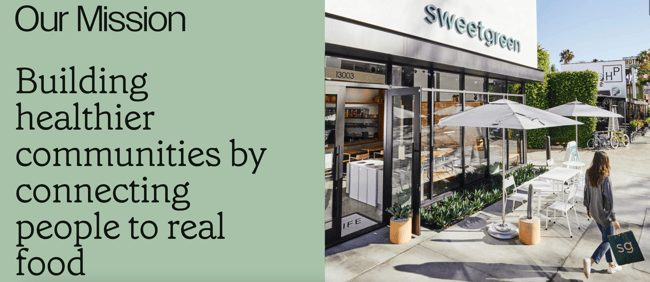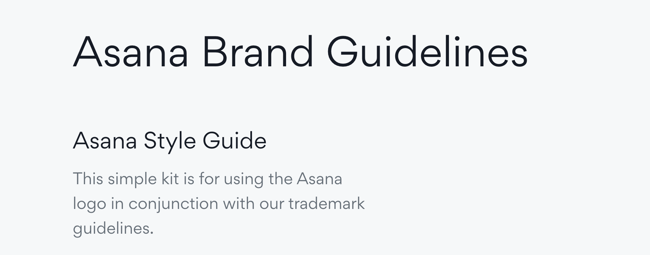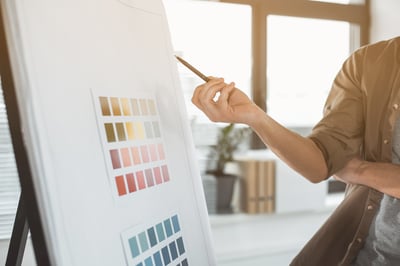October 31, 2022
 by Annisha Lashand / October 31, 2022
by Annisha Lashand / October 31, 2022

When it comes to business, branding is everything.
With a solid brand identity, your company is more recognizable to your audience. Better still, the public's perceived value of your company grows exponentially.
As you grow your product or service offerings, keeping your brand consistent and aligned across the board is tricky. The solution? Brand guidelines. Clear and easy-to-follow brand guidelines are like insurance on your business' representation to the public.
In this post, we'll explain why brand guidelines are so important and everything you need to know to create a detailed brand guide.
Brand guidelines detail how your company or organization presents itself both visually and in writing. They include everything from your logo and color palette to your brand's voice, persona, and values.
With a comprehensive brand guide, your employees and everyone who represents your company can maintain consistency, especially when creating marketing collateral or interacting with customers and the public.
Whether advertising in print, interacting with online followers, or creating social media posts, your brand guidelines ensure that everything you say or create is consistent with what you represent.
They also ensure that internal or external communication with partners, customers, and the general public are handled consistently, regardless of who handles the interaction.
While brand guidelines differ from company to company, keep a few things in mind when creating them. These vital elements act as a framework representing your company.
Here are the top six things to always include in your brand style guide.
A mission statement is a short paragraph summarizing your business’ personal brand statement. It should have three primary elements:
A good mission statement is clear and concise, providing readers with an instant understanding of the very reason your business exists. This statement includes everything from your logo's style to the brand's voice, making it a vital component of your brand guidelines. Start your guidelines with your mission statement for immediate impact.
Think of your business as a person – what is it like? Is it funny? Caring? Energetic? Down to earth? A bit rebellious? These are the things that make up a brand persona and are vital when developing the brand's voice.
Brand persona makes your business unique and sets it apart from others in your industry. It should also reflect your customers. Make sure to detail the key characteristics of your brand persona in your guidelines.
Brand voice is how you communicate – usually in writing – with customers, employees, and the general public. It includes:
Detailing the core aspects of your brand voice will help keep people aligned when writing on behalf of your business or speaking about it in public.
The logo is likely the most recognizable aspect of your branding, so your team should get it right. Include a sample of your logo and rules about where and when to use it in your brand guidelines, acceptable sizes and file formats for digital use, and color variation.
Be sure to include black-and-white logo variations as well.
Fonts are an important part of any brand. The right font can speak volumes about a brand persona, while the wrong one can detract readers and make your business appear unprofessional or unpolished.
Include accepted fonts and font sizes in your brand guidelines and rules for when and how to use these fonts. You’ll want to include information on what fonts to use for, let’s say, header copy, subtitle text, and body copy. If you use custom fonts, include a second option that is more commonly accessible for use in a pinch.
The color palette likely consists of a small selection of colors complementary to your logo. Include an example of these colors in your brand guide and RGB and CMYK codes to ensure that designers and employees can use exact color matches in marketing materials and communications.
Seeing examples makes it much easier to visualize them. Some businesses have their brand guidelines down to a science. These companies include everything employees and representatives need to know about their brand without confusing the reader.
Time to learn from the best! Check out these examples of a few brands with great brand guidelines.
Uber's brand guidelines get straight to the point, stating the company’s mission as a clear solution to a common problem. Created in the brand's signature style, the guide provides readers with an example of how the brand language should look.
It offers clear examples of the logo, including how to create and display it, colors, map samples, and links to the color palette and fonts approved for use.

Source: Uber
The moment you look at the Spotify brand guide, rules regarding the brand's logo and acceptable colors are clear. The brand has done an excellent job of indicating acceptable colors for its logo, where and when each color should appear, and proper logo sizing.
Spotify has also included examples of how not to use its logo, including font and color combinations and unpermitted aspect ratios.

Source: Spotify
Sweetgreen has undergone a major brand evolution. Today, its marketing efforts indicate what the company is about. Its brand guidelines have done a great job reflecting its mission, vision, and values through concise and to-the-point language.
Single-word brand values and a short, two-paragraph mission guide the reader through the rule book, providing clear information about acceptable colors, logo usage, and brand voice.

Source: Sweetgreen
Asana has taken the liberty of publishing its brand guidelines online for all to read. It uses fun language to explain exactly how its logo can and cannot be used. It includes clear branding guidelines to ensure that any person or company that references the brand can do so in a way consistent with Asana's brand guidelines.

Source: Asana
Writing brand guidelines takes time. You need to deeply understand your company and why you got into business in the first place.
Before you start, create an outline of the sections you want to include in your guidelines and bullet points in each section detailing the topics you want to cover. This should inspire and guide you throughout the writing process.
Below are some tips for developing great brand guidelines.
The number one rule? Show, don’t tell! When you create your brand guide, adhere to the rules you set out in it. Use your color palette throughout the guide, include your logo throughout the pages, and don't be afraid to write your branding rules in your brand persona.
Don't forget to follow the guidelines you created for your brand voice and speak in the same tone you expect to use in all future marketing materials. By creating a brand guide that follows the same rules you created for your company, you give employees and agents a clear example of what to expect from future communications.
If your company is large, tens, hundreds, or even thousands of employees will read your brand guidelines. This can leave a lot of room for misinterpretation. That's why creating a clear and simplified brand guide is essential.
Include precise rules about what you do and don't expect to see in your brand persona and brand voice guidelines. Show clear examples of the colors, imagery, and logo expectations.
Just as it's important to include examples of how your logo should be used, it's vital to give your employees and representatives clear visual representations of how you don't want your marketing materials to look.
It can be helpful to create a page of color combinations of your logo and brand name that you don't approve of, or icons and photograph styles that aren't a good fit for your brand's image.
Brand guides can only do so much for your business if published internally. Add them to your website for public use by bloggers, influencers, and other brand promoters to help them understand how you want your business represented.
Also, include brand guidelines in a public forum like the company website to make your copyright and trademark guidelines clear. When publishing your brand guide online, consider placing it on a subpage under the about page, or place a link to it with the contact information. This ensures the brand guide is accessible without overtaking other important parts of the website.
Forty-eight percent of consumers are more likely to pay a higher price for goods and services from a brand they recognize and trust. That alone signals building a brand that the general public recognizes.
Without consistent branding among the employees and marketing teams representing your company, your promotional and communication efforts risk being viewed as irrelevant and unrecognizable. It's important to have a solid brand guide accessible to everyone linked to your business.
When creating a brand guide, include the following:
Incorporating brand guidelines into your onboarding process allows new employees to understand your business and how to represent it. This ensures consistency across the board, whether customers interact with you in person, through your website, or on social media.
To build a brand reputation, you need to build its equity. Learn more about brand equity and how positive equity helps scale a business.
Annisha is the Head of Content at Looka. Through her work, Annisha has helped thousands of people build comprehensive brands. When she's not writing about branding, design, and entrepreneurship, you can find her writing poetry on her Instagram.
There is (arguably) nothing more reassuring than consistency. It makes us feel safe and it...
 by Daniella Alscher
by Daniella Alscher
A brand is absolutely nothing without consistency.
 by Hannah Tow
by Hannah Tow
Building a brand is a delicate process.
 by Hannah Tow
by Hannah Tow
There is (arguably) nothing more reassuring than consistency. It makes us feel safe and it...
 by Daniella Alscher
by Daniella Alscher
A brand is absolutely nothing without consistency.
 by Hannah Tow
by Hannah Tow


